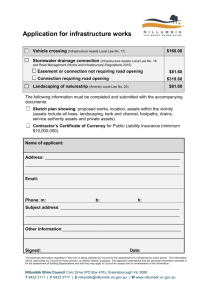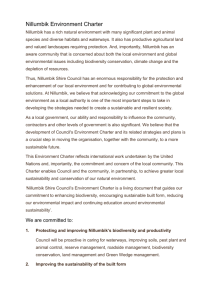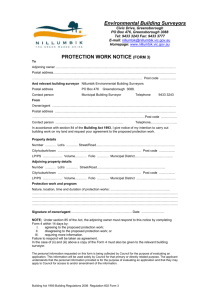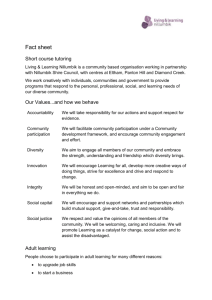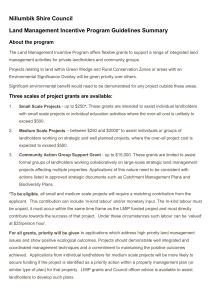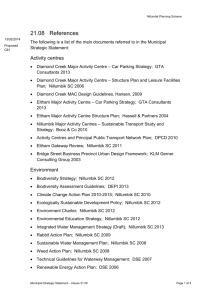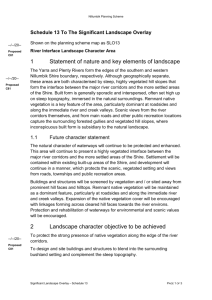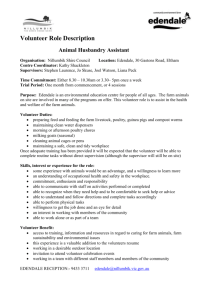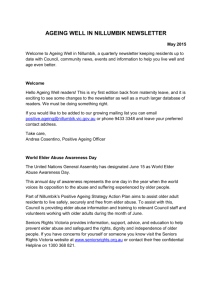Integrated Children, Youth and Families Strategy: Birth to 25 Years
advertisement
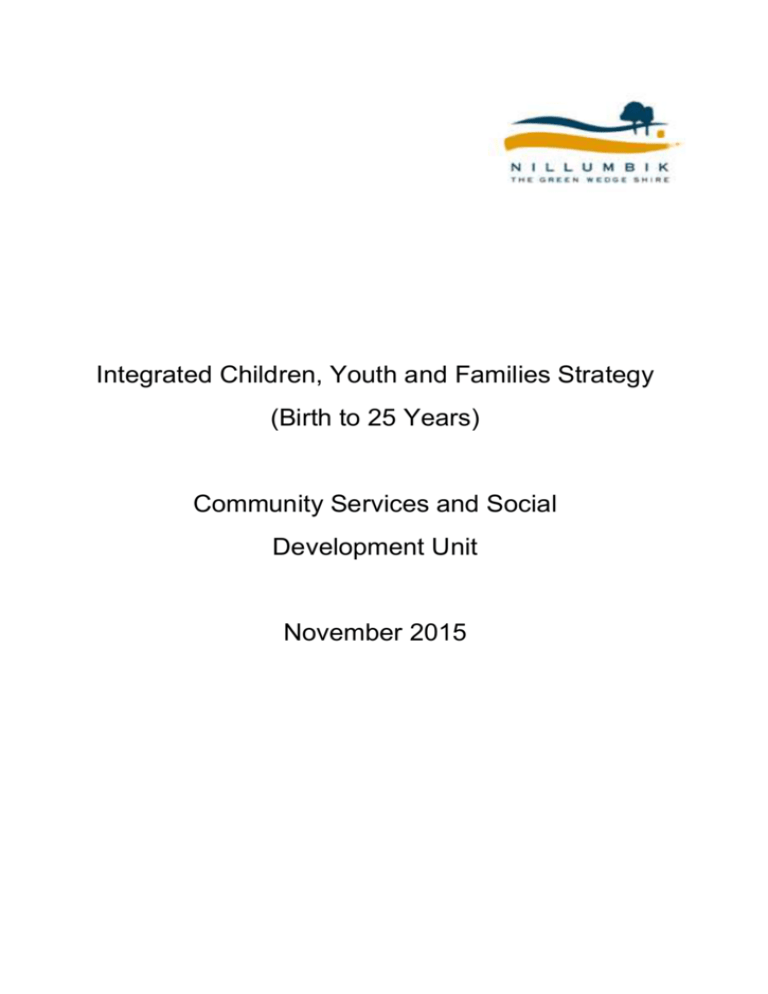
Integrated Children, Youth and Families Strategy (Birth to 25 Years) Community Services and Social Development Unit November 2015 Table of Contents INTRODUCTION .................................................................................................................................... 3 POLICY CONTEXT ................................................................................................................................ 4 INTEGRATED CHILDREN, YOUTH AND FAMILIES STRATEGY – BIRTH TO 25 YEARS .................. 6 Purpose ................................................................................................................................................. 6 COMMUNITY CONSULTATION PROCESS .......................................................................................... 7 NILLUMBIK INDICATORS OF WELLBEING FOR CHILDREN, FAMILIES AND YOUNG PEOPLE ..... 9 CHALLENGES AND OPPORTUNITIES............................................................................................... 16 STRATEGIC FRAMEWORK: A SHIFT TOWARDS OUTCOMES ........................................................ 18 PRIORITY DIRECTIONS ...................................................................................................................... 20 FOCUS AREAS TO STRENGTHEN THE COMMUNITY SERVICE SYSTEM IN NILLUMBIK ............. 20 NILLUMBIK COUNCIL COMMUNITY SERVICE STRUCTURE ........................................................... 21 ACTION PLAN 2015-2020 ................................................................................................................... 23 REFERENCES ..................................................................................................................................... 34 2 Introduction The Integrated Children, Youth and Families Strategy: Birth to 25 years aims to improve the wellbeing of children, families and young people from birth to 25 years of age living in the Shire of Nillumbik. The Strategy focuses on how Council programs and services can better planned and realigned to provide an integrated community services system across key life stages and transition points. The development of a Children, Youth and Families Strategy: Birth to 25 years builds on the Nillumbik Municipal Early Years Plan 2009-2013 which has lapsed and other strategic directions in relation to young people and families. It is about achieving the best outcomes for children, families and young people that are integrated, prevention-focused and evidence based. Council recognises that to achieve these outcomes we must maximise our efforts in addressing the opportunities, gaps and barriers to the community service system in a collaborative way. To do this Council alone cannot meet all the needs of children, families, and young people by one program, service, or facility or by working in isolation. It is acknowledged that local agencies and organisations play a critical role in providing community services for individuals and families in Nillumbik. However this Strategy primarily focuses on the community services and facilities which Council is responsible for planning and delivering. The Strategy will demonstrate how Council can strengthen and enhance the wellbeing outcomes of children, young people and families in an integrated and sustainable way; and how Council could best respond to the emerging trends and challenges affecting children and young people from birth to 25 years of age over the next five years. More importantly the Strategy will provide a vehicle for improving service planning, programs, services, facilities and infrastructure that will respond to the emerging trends and challenges for the next generation. The audience for this Strategy is primarily Council led programs and services. The actions outlined in the Strategy will provide a framework for engaging other stakeholders in consolidating existing partnerships and collaborations and / or forging new ones. Using a life stages approach will assist Council to understand its role and responsibilities in planning, service delivery and evaluation of community services and infrastructure in the Shire. By taking a renewed focus on children, young people and families will enable Council to adopt a seamless and collaborative approach in responding to community needs and wellbeing outcomes. This focus includes meeting our obligations under Australian and Victorian laws, and the human rights principles which Council is committed to such as inclusion for people aged birth to 25 years experiencing disability. 3 Policy Context Council’s work with children, young people and families is supported by several existing Council policies, departmental and business plans. Much of the Council’s community service delivery is coordinated through the Community and Leisure Services Department, with other Council departments contributing either directly or indirectly towards the wellbeing outcomes of children, young people and families. There are several key policies, legislation and regulations that underpin Council’s direct service provision with children, young people and families. These policies, legislation and regulations stipulate the role of local government in the delivery of community services and infrastructure and form the basis on which Council plans and delivers services. This context is important because it outlines the many and varied responsibilities and levers Council has to ensure the health and wellbeing of children young people and families is protected, promoted and prevented from avoidable harms and conditions. These include: Local Government Act (1989) Public Health and Wellbeing Act (2008) Child Wellbeing and Safety Act (2005) Working with Children Act 2005 Disability Act 2006 Educational and Care Services National Regulations 2011 Children’s Services Regulations 2009 Nillumbik Council Plan 2013-2017 Nillumbik Health and Wellbeing Plan 2013-2017 Municipal Early Years Plan 2009-2013 Maternal Child and Health Service Plan 2014-2015 A significant and important policy context influencing this Strategy is the Australian Research Alliance for Children and Youth (ARACY) vision and policy agenda. Our shared vision for Australia’s children and youth (aged 0-24) is an Australia where: “All young people are loved and safe, have material basics, are healthy, are learning and participating and have a positive sense of identity and culture” ARACY 2014 4 ARACY’s NEST Action Agenda is Australia's first ever national plan for child and youth wellbeing. NEST was developed following evidence showing Australia’s children and youth are lagging behind OECD countries across key international child and youth health and wellbeing indicators. NEST is a National Plan seeking to improve the wellbeing and life opportunities of all young Australians based on collaborative action and cross-sector endorsement. Adapting NEST as a model for Nillumbik will strengthen Council’s prevention and early intervention focus. It will also enable Community Services staff to work proactively with the local community, service providers and agencies to plan and provide effective services and infrastructure for children, young people and families. The Strategy is also influenced by the Victorian Charter for Child Friendly Cities and Communities, which is developed specifically for local governments, organisations and individuals to take action to implement the right for cities to be considered child friendly. The Charter is consistent with State, National and International protocols and embraces rights as a policy framework, aligned with the Convention of the Rights of the Child (1990), the Chiba Declaration for a Child Friendly Asia Pacific (2009), UNICEF’s Building Blocks for Developing a Child Friendly City (2004) and the Victorian Human Rights and Responsibilities Charter 2006. In 2015 Nillumbik Council adopted the Victorian Chapter of the Child Friendly Cities (VLGA) which recognises the need for increased participation by children in decision-making forums and creating child friendly environments, and supports the following principles: Freedom for children to experience environments that consider their needs Respect and dignity for children to express their individual opinions, participate in and contribute to decisions about their communities and their wellbeing Equitable access to supportive environments While Council is committed to achieving positive outcomes for children, young people and families, it faces a level of uncertainty and complexity as a result of external changes and reforms to the community service system in the future. Resources Currently the operational budget applied to Children, Youth and Family Services for 2014-2015 by Nillumbik Council is $1.6 million. (This figure excludes immunisation, the L2P Driver Program, FreeZa program, and all expenditure on early years facilities). In terms of the early years facilities, the Community Services and Social Development Unit is responsible for maintaining and managing 31 facilities. Adapting to demographic changes, external drivers and reforms will continue to be a challenge for Council going forward. Many of these changes and reforms will impact significantly on the volume and quality of community service delivery. Council is not alone in facing shifts in policy from Victorian and 5 Federal Governments such as the National Disability and Insurance Scheme (NDIS), Home and Community Care (HACC), universal access for preschool, childcare and Family Day Care. Ensuring the provision of quality services and accessible facilities is a priority goal for our community service system. At least 70% of funding for Council community services is reliant on external funding and there are emerging demands and constraints on the existing service system. The challenge ahead is to plan more efficiently for these changes and work effectively with other local agencies in a climate of uncertain and diminishing funds and resources. Integrated Children, Youth and Families Strategy: Birth to 25 Years Purpose The Strategy ensures that the current range of services, programs, facilities and infrastructure can be more adaptive and flexible to the emerging trends and changing demographics affecting the Nillumbik population from birth to 25 years. By doing this Council can be more focussed on generating whole of community outcomes. Taking an outcomes approach will enable greater integration between programs and ensure the service system is responsive to the diverse and complex needs of children, young people and families. The Strategy draws on demographic, service mapping and utilization data to inform the priority directions and actions for children, youth and family services and facilities over the next 5 years. Importantly this Strategy is aligned with the priorities in the Nillumbik Council Plan 2013-2017, Nillumbik Health and Wellbeing Plan 2013-2017 and internal business plans to ensure consistency and achievable actions are delivered in a timely manner. Vision Our shared vision for the Nillumbik community is to facilitate an environment where: All children, young people and families are active, healthy and resilient. Principles (adapted from ARACY 2013) 1. A commitment to a long-term, evidence-informed approach 2. A commitment to prevention and early intervention 3. A commitment to a life-stage approach 4. A commitment to child, youth and family sensitive practice. 5. A commitment to universal services platform 6. A commitment to working collaborative and in partnership with others. 6 Community Consultation Process Nillumbik Council regularly consults with young people, families, service providers and local organisations about what is important to them in relation to the quality and breadth of services and facilities catering from birth to 25 years in the municipality. In addition to its community planning and research, Council has facilitated community consultation in several ways as part of the development of this Strategy: Conducted several internal consultations and workshops with Nillumbik Council Community Services and Social Development Unit staff Conducted an internal Service Review on Children, Youth and Family Services (February 2015) Developed Nillumbik Child, Youth and Families Profile 2015 (evidence base) Hosted the Best Start Seminar (18 March 2015) Evaluated the Municipal Early Years Plan 2009-2013 (June - July 2015) Developed and circulated the Integrating Child, Family and Youth Services (Birth to 25 Years) Discussion Paper in July 2015 Conducted stakeholder consultations in July and August 2015 Conducted an online parent survey Conducted parent information seminars on topics parents and schools identified in online surveys Facilitated activities with children – Mayor for a Day and Child Friendly Cities Charter. Key Outcomes from the Consultation The evidence from community consultations and surveys suggests that these services are of high quality and are highly valued. The strengths include: A very well used and highly regarded maternal and child health service; Preschools that cater for all eligible four-year olds and offer many three year old programs. Quality audits which have been conducted in preschools show they have met all required standards and six preschools exceeded the standards; Occasional Care services that are well-utilised and have highly satisfied users; A Family Day Care service that was rated highly in the independent quality audit. No waiting lists for services – other than long day care, Youth Services are well-regarded by young people, families and service providers; and A positive overall rating of services in the community satisfaction survey 7 The Nillumbik Annual Community Survey asks residents to rate the level of importance and satisfaction with Council services. Over the last 2 years Nillumbik residents have rated their satisfaction with Maternal Child and Health Children and Family Services and Youth Services highly. This rating is scored out of 10 and is listed in the table below: Resident Satisfaction Survey Service Community Satisfaction Rating 2013 Community Satisfaction Rating 2014 Community Satisfaction Rating 2015 Children’s services 7.91 7.76 8.25 Youth services 6.85 6.75 7.83 This suggests that the services offered by Council for children, young people and families is having a positive impact in the community and continues to be valued by the residents who use them. Several community consultations with residents including young people, parents, service providers and agencies have identified that there are gaps in the range and breadth of community services provided by external non-government and not profit organisations. Inner and middle ring municipalities tend to have a wide range of services for families to access which, with limited exceptions, are not available in Nillumbik. The Nillumbik Best Start Seminar: Shaping the Future of Nillumbik’s Families and Children held on Wednesday 18 March 2015 involved over 100 participants. The outcomes of the seminar were positive and insightful. Much of the feedback from participants pointed to the need for planning to respond to future changes and service demand; adapting to rapid technological and communication changes; managing the complex needs of families and expectations of funding bodies; responding proactively to reforms to the early year’s sector and funding constraints. Overall the key theme for the Best Start Partnership going forward is “not falling behind a fast paced and changing world”. The community consultation with key stakeholders held on Tuesday 28 July 2015 identified many issues affecting children, young people and families in the Shire. It also identified many new ideas and ways in which Council can explore opportunities for collaboration and partnerships. Key themes for maximising stronger connections between services, agencies and Council related to information and knowledge sharing, community planning, advocacy, creativity, innovation and social care, particularly in light of recent Government reforms and changes to service provision. The outcomes of this consultation are captured in a report attached to this Strategy. 8 Nillumbik Indicators of Wellbeing for Children, Families and Young People When comparing indicators over the time span of the Nillumbik Municipal Early Years Plan 2009-2013, there have been a number of positive improvements and areas that could be better strengthened in the future. Positive impacts Childhood indicators are mostly remaining at extremely healthy levels, or improving; Increased knowledge and improved responsiveness to community needs; Strengthened networks, partnerships, and communication systems Hurstbridge Family Hub established and currently working on Eltham and Diamond Creek Hub. Areas for improvement • • • • Increase rates childhood vaccination; Support for children with speech and language difficulties; Improving nutrition (fruit and vegetable intake) for children in the community; Family violence, and violence where children are present is an emerging concern in the community. Nillumbik Children and Families: Indicators of Wellbeing Over Time Census data from 2006 and 2011 compares populations over the life of the Early Years Plan 2009-2013. Population Changes In the five years between 2006 and 2011, the population grew, but the number of children aged 0-8 years fell slightly. Over this period, the number of families with children under 15 years also fell, but the number of one-parent families increased. Year Total population of Shire of Nillumbik 2006 2011 59,791 60,345 Number of children aged 0-8 years 7,366 7,029 Families with children aged 15 and under Couple families with children aged 15 and under One-parent families with children aged 15 and under 7,158 6,761 6,328 5,906 830 855 Source: Australian Bureau of Statistics, Census of Population and Housing, 2006 & 2011 9 Socio-economic changes In the five years between 2006 and 2011, the median family income rose by 25%, and the median monthly mortgage repayment rose by 36%. Home ownership increased slightly. In 2011, Nillumbik was ranked the least disadvantaged of the 80 local government areas (LGAs) in Victoria based on the SEIFA index of disadvantage1. Nillumbik socio-economic profile – with changes between censuses Year Median weekly family income (Vic) Unemployment rate (Vic) Median monthly mortgage repayment (Vic) Own or purchasing home (Vic) Rank Socioeconomic disadvantage among LGAs (Vic) 2006 2011 $1657 ($1170) $2070 ($1460) 3.0% (5.4%) 3.5% (5.4%) $1430 ($1252) $1950 ($1700) 86% (71.7%) 87% (70.1%) 79/80 80/80 Source: Australian Bureau of Statistics, Census of Population and Housing, 2006 & 2011Victorian state averages are shown in brackets Free from preventable disease – children fully immunised Proportion of children fully immunised in Nillumbik Year 2009 2013 Fully immunised at 12-15 months % (Vic) 91.7 (91.9) 91.7 (91.7) Fully immunised at 24-27 months % (Vic) 90.4 (93.7) 91.0 (91.7) Fully immunised at 60-63 months (Vic) 83.0 (84.1) 93.5 (92.6) Source: VCAMS 2010 Early Childhood Community Profile and 2012/13 spreadsheets (Victorian state averages are shown in brackets) There was an increase in immunisation rates in Nillumbik. The percentage of children fully immunised at 60-63 months was previously below the state average, but is now exceeds the state average. Physical health and wellbeing - physical readiness for the school day, physical independence, gross and fine motor skills. AEDI results for Nillumbik: Physical health and wellbeing domain Year 2009 2012 Developmentally vulnerable % 3.5 (7.7) 3.1 (7.8) Developmentally at risk % 6.2 (11.7) 14.2 (11.1) Developmentally on track % 90.3 (80.6) 82.7 (81.2) Source: AEDI Community Profiles 2011 and 2012 (Victorian state averages are shown in brackets) There was a decrease in developmental vulnerability on physical health and wellbeing in Nillumbik, but the difference was not big enough to be significant. 1 Socio-Economic Indexes for Areas is a value derived from Census data. 10 Social competence - overall social competence, responsibility and respect, approaches to learning, readiness to explore new things. AEDI results for Nillumbik: Social competence domain Year 2009 2012 Developmentally vulnerable % 3.2 (8.4) 5.2 (8.1) Developmentally at risk % 9.3 (14.0) 9.8 (13.3) Developmentally on track % 87.5 (77.6) 85.0 (78.6) Source: AEDI Community Profiles 2011 and 2012 (Victorian state averages are shown in brackets) There was a significant increase in developmental vulnerability on the social competence domain in Nillumbik. Emotional maturity – pro-social and helping behaviour, anxious, fearful and aggressive behaviour, hyperactivity and inattention. AEDI results for Nillumbik: Emotional maturity domain Year 2009 2012 Developmentally vulnerable % 4.5 (8.3) 4.2 (7.2) Developmentally at risk % 11.3 (14.5) 9.2 (13.5) Developmentally on track % 84.2 (77.2) 86.6 (79.4) Source: AEDI Community Profiles 2011 and 2012 (Victorian state averages are shown in brackets) There was a decrease in vulnerability on the emotional maturity domain in Nillumbik, but the difference was not big enough to be significant. Language and cognitive skills – basic literacy, interest in literacy/numeracy and memory, advanced literacy, basic numeracy. AEDI results for Nillumbik: Language and cognitive skills domain Year 2009 2012 Developmentally vulnerable % 3.6 (6.1) 2.6 (6.1) Developmentally at risk % 7.8 (9.9) 8.7 (9.9) Developmentally on track % 88.6 (84.0) 88.7 (84.0) Source: AEDI Community Profiles 2011 and 2012 (Victorian state averages are shown in brackets) There was a decrease in vulnerability on the language and cognitive skills domain in Nillumbik, but the difference was not big enough to be significant. The proportion of children developmentally on track remained at a similar rate. Communication skills and general knowledge – story-telling ability, communication with adults and children. 11 AEDI results for Nillumbik: Communication skills and general knowledge domain Year Developmentally vulnerable % 2.4 (8.3) 2.0 (8.0) 2009 2012 Developmentally at risk % 8.0 (15.0) 15.0 (14.6) Developmentally on track % 89.6 (76.7) 83.1 (77.4) Source: AEDI Community Profiles 2011 and 2012 (Victorian state averages are shown in brackets) There was a decrease in vulnerability on the communication skills and general knowledge domain in Nillumbik, but the difference was not big enough to be significant. Optimal antenatal development – infants exposed to tobacco and alcohol in utero Proportion of children exposed to tobacco or alcohol in utero in the North East Melbourne region Year 2009 2013 Exposure to tobacco % 7.5 (18.3) Data gap Exposure to alcohol % 72.0 (59.8) 61.9 (46.7) Source: VCAMS 2010 Early Childhood Community Profile and 2012/13 spreadsheets (Victorian state averages are shown in brackets) There was a decrease in exposure to alcohol in utero in the North East region of Melbourne; however this number is still significantly higher than the state average. The Early Childhood Community profile suggests that most women who drink or smoke during their pregnancy do so before they realise they are pregnant. Adequate nutrition – children are fed according to dietary guidelines Proportion of children fed according to recommended guidelines in Nillumbik and North East Region Year Fully breastfed at 3 months % Fully breastfed at 6 months % Children 4-12 Children 4-12 years Children 4-12 years who years who eat who eat eat recommended fruit recommended recommended and vegetables fruit vegetables North East Region* North East* North East Region* 2009 65.5 (51.4) 52.2 (37.9) No data (54.6) No data (3.0) 31.5 (34.7) 2013 68.8 (51.0) 55.0 (33.8) 72.0 (73.2) 3.1 (2.9) 2.6 (2.6) *Data for North Eastern Melbourne Area is given where unavailable at LGA level. Source: VCAMS 2010 Early Childhood Community Profile and 2012/13 spreadsheets (Victorian state averages are shown in brackets) 12 There was an increase in breastfeeding in Nillumbik. The extreme difference in reported children’s fruit and vegetable intake is unexplained and consistent across all regions. This likely to be due to a difference in the way data is collected or presented. VCAMS data from 2006 and 2009 showed that children’s consumption of take away food and fries decreased slightly, but this data is not available for 2013. Early identification of and attention to child health needs – attendance at the 3.5 year key ages and stages visit Children attending the 3.5 year key ages and stages visit in Nillumbik Year 2009 2013 Number of children attending 567 592 Proportion of children attending % 71.8 (58.3) 77.8 (66.5) Source: VCAMS Indicator Data spreadsheets (Victorian state averages are shown in brackets) There was an increase in the number of children attending the 3.5 year key ages and stages visit. Free from abuse and neglect – number of children who are the subject of child abuse substantiation, number of children in out of home care, and family violence incidents. Children aged 0-17 years subject to child abuse substantiations in Nillumbik Year Number of substantiations Rate per 1,000 children aged 0-17 years 2010 2011 15 25 0.9 (5.8) 1.6 (6.7) Source: VCAMS Indicator Data spreadsheets (Victorian state averages are shown in brackets) Children aged 0-17 years in out of home care in Nillumbik Year Number of children in out of home care 2009 2011 33 35 Rate per 1,000 children aged 0-17 years 2.0 (4.4) 2.2 (4.6) Source: VCAMS Indicator Data spreadsheets (Victorian state averages are shown in brackets) 13 Reported family violence incidents in Nillumbik Year Number of incidents Family violence Incidents with incidents children present 219 84 340 108 2010 2013 Rate per 100,000 Family violence Incidents with incidents children present 348.8 (658.4) 133.8 (234.2) 541.8 (1,065.4) 172.1 (331.8) Source: Victoria Police Family Incident Reports (Victorian state averages are shown in brackets) There was an increase in child abuse notifications that were substantiated in Nillumbik, and an increase in the number of children in out of home care. Family violence incidents reported by police increased by 55%, and the number of incidents with children present increased by 29%. Positive family functioning - children living in families with high levels of family stress Children at school entry whose parents report high levels of family stress in the past month Year 2009 2013 Number of children 114 66 Proportion of children % 13.3 (10.5) 9.5 (11.2) Source: VCAMS Indicator Data spreadsheets (Victorian state averages are shown in brackets) There was a decrease in the number of children at school entry whose parents reported high levels of family stress. Indicators of Wellbeing for Young People in Nillumbik Sedentary behaviour The proportion of Northern region children aged 5-12 years who used electronic media for more than two hours per day was 14.2% in 2009 (DEECD, 2010). Over 2 hours per day use of electronic media was reported by 51.4% of Nillumbik adolescents (DEECD, 2011). A high proportion of adults reporting sitting for 7 hours a day or more, and 42.2% spent most of their time sitting at work (Department of Health, 2014). Physical activity and sedentary behaviour by age group 5-12 years * 13-17 years Adults 18+ % doing recommended amount of physical exercise 55.3 (60.3) 10.3 (12.3) 65.2 (63.9) % exceeding recommended electronic media time % sitting for more than 7 hours per day 14.2 (18.8) 51.4 (58.7) n/a n/a n/a 32.2 (32.6) *statistics given for Northern metropolitan region Source: Victorian Population Health Survey, 2011-12, VicHealth Indicators Survey, 2011, Early Childhood and Adolescent Community Profiles, 2010 (Victorian rates shown in brackets) 14 Daily Diet: Fruit and Vegetable Intake In Nillumbik, only 8.3% per cent of adults meet the dietary guidelines for both fruit and vegetable consumption (Department of Health, 2014). In 2009, 19.1 per cent of adolescents in Nillumbik were eating the minimum recommended serves of fruit and vegetables each day (DEECD, 2011). Only 2.6% of children aged 4-12 meet the guidelines for both fruit and vegetables in the North East Region (VCAMS, 2013). Age group Meeting Fruit guidelines % Meeting Veg guidelines % 5-12 years 13-17 years Adults 18+ 72 (73.2)* No data 3.1 (2.9)* No data Meeting both Fruit & Veg % 2.6 (2.6)* 19.1 (19.0) 8.3 *statistics given for Northern metropolitan region Source: Victorian Population Health Survey, 2011-12, VicHealth Indicators Survey, 2011, Early Childhood and Adolescent Community Profiles, 2010 (Victorian rates shown in brackets) Alcohol In 2009, 41.6 per cent of adolescents aged 12 to 14 surveyed in Nillumbik had consumed alcohol. Among older adolescents aged 15 to 17 years, 74.9 per cent had consumed alcohol and 51.9 per cent having done so in the last 30 days. These rates are similar for Victoria (DEECD, 2011) Smoking In 2009, 9 per cent of adolescents aged 12 to 14 years in Nillumbik and 36.1 per cent of older adolescents (aged 15 to 17 years), reported that they had smoked cigarettes, similar to Victorian averages (DEECD, 2011). Drug use and harms In the general population, pharmaceutical drug use is responsible for more drug-related ambulance attendances and Emergency Department presentations than illicit drugs. In Nillumbik, this is also true, but at lower rates than the Victorian average. There is an exception for young people aged 15-24, who experienced harm from pharmaceutical drugs at a similar to rate to the Victorian average. 15 Drug related interactions with the health system in Nillumbik, 2012-13 Indicator Ambulance attendance Ambulance attendance 15-24 yrs Emergency department presentations Emergency department presentations 15-24 years Pharmaceutical drugs Events Rate per 10,000 pop 89 14.1 (21.5) nd 22.6 (22.2) 56 8.9 (12.6) 27 27.7 (28.3) Events 30 15 12 n/d Illicit drugs Rate per 10,000 pop 4.8 (11.2) 14.9 (27.8) 1.9 (2.1) No data Source: Turning Point AOD Stats, 2014 (Victorian rates shown in brackets) More statistics on drugs in Nillumbik In 2009, 4.5 per cent of adolescents aged 12 to 14 years, and 14.4% of 15-17 year olds in Nillumbik had tried marijuana, similar to Victorian averages (DEECD, 2011). A recent study found that 1.9% of all Victorians aged 14 and over, used methamphetamine (AIHW, 2014) Challenges and Opportunities The table below summarises the main funding challenges and opportunities which are likely to impact on the community service system in the municipality. The drivers for many of these challenges and opportunities are Government reforms and changes between 2015 – 2018. Federal Government State Government Local Government Best Start: focussing is shifting towards vulnerable children who are missing out. Early Years Capital Funding: $50m for 4 years & Early Intervention Services funding $48m over 4 years Impact of NDIS reforms and HACC on local services from July 2016 NDIS: significant reforms and changes to occur from 2018 SFYS: due to cease December 2015. Review is underway and the future of the program is uncertain. Victorian Local Government Act 1989 under review Youth Connections: ceases in December 2014 Supported Parents Playgroups Initiative: eligibility criteria changed (healthcare card only) and funding will cease from 1 July 2016 for majority of Nillumbik residents Nillumbik Municipal Early Years Plan 2009-2013 has lapsed Family Day Care: funding ceases June 2016 Universal Access 4 year olds: continuing for 2 more years until 2017 Cost shifting to local government from Federal / State policy settings: such as community transport 16 Australian Youth Week funding reduced and is unknown beyond 2017 Maternal Child and Health: streamlining data systems operational from July 2015 Nillumbik Community Hubs: Hurstbridge complete, Diamond Creek and Eltham to start soon Headspace Greensborough approved in July 2015 and scheduled for opening early 2016 Reconnect: funding due to cease in June 2016 Banyule Nillumbik Local Learning and Employment Network: reduced funding for another 3 years until 2019 Closure of 1 Playhouse TAFE Greensborough: planned to reopen in 2017 and will integrate proposed Greensborough Tech School on the site L2P: funding extended for another 4 years Internal Children, Youth and Family Services Review was conducted early 2015 Inclusion Support Assistance funding unknown beyond July 2016 Rate capping - transition planned from 2016-17. Transition to Employment 2016 - 2019 Review of Immunisation Services 2015 For Nillumbik Council there are additional challenges which have emerged from the consultation process and current policy reforms that are likely to affect planning and decision for Council as well as other local governments in Victoria. These can be summarised as: Facilitating catchment based planning – planning cycles for Local Government, State and Federal governments are out of alignment and the drivers are partly changes to social policy for aged and disability services, child care and kindergarten, regulation and legislation and health and wellbeing plans. Continuing to provide universal services once the National Disability Insurance Scheme (NDIS) reforms are in place which focus on individualised care in the community; Enabling prevention and early intervention for optimal health and wellbeing outcomes for children, young people and families in a rapidly changing policy and diminishing funding environment and achieve priority directions under the Municipal Health and Wellbeing Plans 2013-2017; Actively supporting community service and crisis response in the Nillumbik municipality in relation to homelessness, family violence, substance abuse and mental health and psychological support for young people and families; Forging collaborative partnerships and networks to create entry points for Nillumbik Council’s work in supporting and strengthening the community service system; and Understanding the implications of the potential introduction of rate capping for Nillumbik, particularly in relation to resourcing community services in the next 4 years. 17 The Collaborative Opportunities for Council Community Services As indicated in the Nillumbik Health and Wellbeing Plan 2013-2017 Council will establish an integrated child, youth and family planning network to bring together relevant agencies to discuss and identify the key issues and gaps affecting children, young people and families in the Shire. This network would align closely with the goals and strategic actions in Nillumbik Early Years Network, Best Start Partnership, Headspace Greensborough Partnership, Banyule Nillumbik Youth Services Network and other local priorities. It could also act as a platform for developing strategic partnerships with service providers, researchers, academic institutions and community groups to plan and advocate for the needs of the community. Council is also seeking to strengthen service delivery referral and program development opportunities with community service organisations such as Berry Street, Nillumbik Health, MIND Australia, Relationships Australia, and the Eastern Melbourne PHN as well as relevant networks and partnerships which support particular needs and issues in the community. Additionally Nillumbik Council will continue to work closely at a regional and subregional level with neighbouring Councils such as Banyule, Whittlesea and Darebin on matters of mutual interest, catchment planning and advocacy (for example planning and funding to support youth services in the Northern metropolitan region). Council invests considerable time and effort in supporting community representatives and committees of management to retain local ownership and direction of early childhood services such as kindergartens and playhouses. This will continue to be a priority in terms of strengthening our local engagement and directions for children, family and youth services in the future. Strategic Framework: A Shift towards Outcomes The outcomes are selected from a review of comparative child, youth and family wellbeing domains that are relevant and adaptable to Nillumbik’s demographic and socio-economic circumstances. The key domains are healthy, learning, participating, children, young people and families in supportive relationships (DEECD 2013, ARACY 2013). A suite of agreed indicators for each outcome allows us to monitor and measure progress towards our goals. Together, the outcomes and their indicators provide a comprehensive measurement framework on how Nillumbik’s children and youth are faring. Evidence will be used to measure progress on whether Council is achieving the vision of this Strategy. The four outcomes are inter-related for example, being healthy is essential to full participation and engagement in learning and education. Children and young people’s achievement depends on a complex inter-relationship between individual (child) and family factors, and broader community and societal factors. Because of this complexity, focusing just on one outcome at the exclusion of others will not lead to improvement in overall child and youth wellbeing. 18 That is why three ‘cross-cutting’ priority directions have been identified. It is these priority directions that will enable better integration across the outcomes, and thus, in achieving the ultimate vision for children and youth wellbeing. The framework is captured below linking all the strategic framework for the actions Council will implement in partnership with relevant service providers and organisation over the next 5 years. Strategic Framework for Integrating Child, Youth and Family Services and Facilities in Nillumbik VISION Our shared vision for the Nillumbik community is to facilitate an environment where: All children, young people and families are active, healthy and resilient OUTCOMES AND INDICATORS: HEALTHY LEARNING PARTICIPATING Optimal antenatal breastfeeding and infant development Immunisation rates Optimal language and cognitive development Young people feel able to have a say Early childhood education participation Nutrition activity and health weight Reduce early childhood developmental vulnerability Parental engagement in child learning Safe use and engagement of technology and social media Involvement in organised activities Dental health Healthy physical development Youth participation in education and skills development Good mental health and wellbeing Membership of social, community or cultural groups and events Volunteering SUPPORTIVE RELATIONSHIPS Positive, equal and respectful family relationships Positive parenting practices Positive, trusted peer relationships and communication Feeling safe in the community and at home Bullying prevention Mentor and peer support Access to community facilities, parks and recreation equipment Reduced substance use Priority Directions Strengthen and integrate the service system across the life stages for children, young people and families. Plan and deliver universal and targeted services, programs, facilities and social infrastructure Promote optimal health and wellbeing for all children, young people and families. Focus Areas to Strengthen the Prevention and Early Intervention System Communication and Information Partnerships Coordination Governance Quality 19 Priority Directions Over the next five years, the Community Services and Social Development Unit will to continue providing quality services and facilities for aimed at maximising opportunities for children, young people and families. But in times of financial constraint and uncertainty, the opportunity to provide more services with fewer resources will be challenging. The priority directions Council seeks to influence and strengthen in the community service system are: 1. Strengthen and integrate the service system across the life stages for children, young people and families; 2. Plan and deliver universal and targeted services, programs, facilities and social infrastructure; 3. Promote optimal health and wellbeing for all children, young people and families. These priority directions are drawn from extensive community consultation with stakeholders, parents and young people who have contributed their views through the Integrating Child, Family and Youth Services (Birth to 25 Years) Discussion Paper (July 2015), Best Start Seminar (March 2015), staff workshops, stakeholder and parent workshops and surveys facilitated by Council between 2014-2015. For each priority direction there are a set of interrelated actions that will contribute to the indicators and outcomes for healthy, active and resilient children, young people and families. The priority directions are based on: addressing emerging evidence, trends, needs or gaps; analysis of domains of primary prevention, early intervention and complex intervention across all the service system identifying drivers for change that impact on Council's community services system; finding ways to integrate, improve and strengthen the way in which Council responds to key life stages and critical transition points; providing a balance between universal and targeted service provision to mitigate any emerging risks and vulnerabilities; and maximising efficiencies where resources or funding is limited or unavailable. Focus Areas to Strengthen the Community Service System in Nillumbik In addition to the priority directions, there are key focus areas which are critical in strengthening the prevention and early intervention aspects of the community service system. These key areas are linked to the priority directions and action plan outlined in the later part of the Strategy. 20 Communication and Information: Develop a Communication and Information Strategy Partnerships: Develop and sustain stronger service partnerships: Coordination Strengthen child, youth and family service coordination: Improving communication and information sharing Undertake regular evidence gathering and data analysis Improving information systems to optimise digital access over 24 /7 period Improving the use of social media and web technology Improve catchment based planning Continue service and facility planning at the local, sub regional and regional levels; Enhance universal and targeted access for birth – 25 years; Develop referral guidelines and protocols to streamline connections and linkages; Share service knowledge and eligibility criteria. Address service and facility gaps and duplication; Identify cross LGA (Banyule and Whittlesea) priorities; Case coordination and management wherever relevant and within regulatory guidelines; Identify central point of contact, intake and assessment; Identify priorities for vulnerable population groups, places and issues (e.g. mental health, financial stress, family violence) Governance: Shared policy framework across birth-25 year spectrum; Specific system and governance processes that need to occur Collective accountability and reporting; Professional development and training for staff; Establish on common governance group for children, young people and families; Enhance parenting education Develop a Family Sensitive Practice Model Strengthen evidence base, research and evaluation on what works Improve workforce planning and development Resource allocation and management (facilities) Quality These key focus areas are broadly aligned with the performance audit findings from the Victorian Auditor General on Early intervention services for vulnerable children and families (September 2014) and the Nillumbik Children Youth and Family Services Review (internal) (February 2015) and the Nillumbik Municipal Early Years Plan Evaluation (July 2015). Nillumbik Council Community Service Structure Nillumbik Shire Council’s organisational structure for the birth - 25 age range is arranged so that the Maternal Child and Health Services, Family and Children’s Services and Youth Services all sit under the umbrella of Community Services and Social Development. The structure of Community Services and Social Development also includes Aged and Disability Services and Service Planning and Social Development but the focus for this Strategy is on children, youth and families spanning the birth – 25 years life stage across three key areas: youth, family and children’s services. 21 COMMUNITY SERVICES AND SOCIAL DEVELOPMENT UNIT Aged & Disability Services Service Planning & Social Development Maternal Child and Health Prenatal to 4 years Family and Children’s Services Prenatal to 8 years Youth Services 10 to 25 years Nillumbik Council’s approach to services and infrastructure and facilities for children, young people and families is predominantly focused on enhancing prevention, early intervention actions to improving the education, physical, social and emotional wellbeing of the community. By continuing our investment and resources in this way means we are committed to contributing greater outcomes and savings for the community in the longer term. ARACY Nest Action Agenda refers to the quantifiable benefits of reducing early childhood vulnerability and the corresponding increases in Australia’s productivity in economic terms. Investing in the prevention and early intervention strategies and programs for children and young people contributes to savings in health, welfare, education and justice programs and systems (2014: page) 22 Action Plan 2015-2020 Priority Direction: Strengthening and integrating the service delivery across the life stages for children, young people and families Priority Actions Responsible Area Resources Timeline Key Focus Areas Indicators Investigate ways to improve AEDI developmental Maternal and Child Health Growing 2015 onwards Coordination vulnerabilities in Yarrambat, Panton Hill, St Andrews Communities Family and Children's and surrounds Thriving Services Children (GCTC) Optimal language and cognitive development Leverage funding for a Generalist Youth Worker, Nurse and /or Counsellor for Nillumbik. Good mental health and wellbeing Youth Services External grants to be sought 2015/2016 FY Partnership Reduce early childhood developmental vulnerability Bullying prevention Positive, equal & respectful family relationships Leverage funding for a Middle Years Worker for Nillumbik. Family and Children's Services External grants to be sought 2015/16 FY Coordination Partnership Lead the facilitation of the Greensborough headspace Service Planning and Partnership Social Development Facilitate youth engagement with the service model and evaluation Youth Services Existing MHWP 20132017 2015 onwards Partnership Governance Parental engagement in child learning Positive parenting practices Good mental health and wellbeing Reduced substance use Youth participation in education and skills development 23 Advocate for families with children with disabilities to understand their needs and identify service linkages and opportunities. Explore integrated model of community service provision and library service at the Hurstbridge Community Hub Family and Children's Services Existing budget End of June 2016 TBC. Quality Inclusion Support Alliance (ISA) Family and Children's Services Youth Services Existing budget and external funding Good mental health and wellbeing 2015 onwards Coordination Quality Community Participation Improve and evaluate digital technology and information access for online information and resources, such as Webinars Maternal and Child Health Existing budget Family and Children's Services Positive parenting practices 2015 onwards Communication and Information Youth Services Quality Involvement in organised activities Access to community facilities, parks and recreation equipment Safe use and engagement of technology and social media Positive, trusted peer relationships and communication Facilitate online central enrolment registration and payments and maternal child health streamline database. Maternal and Child Health Existing grant 2015 onwards Communication for online and Information central enrolments Quality Safe use and engagement of technology and social media. Continue to facilitate Best Start Partnership Family and Children's Services Partnership Positive parenting practices Governance Reduce early childhood developmental vulnerability Best Start funding Ongoing 24 Continue to facilitate Nillumbik Early Years Network Family and Children's Services ISA Ongoing Partnership Positive parenting practices Governance Reduce early childhood developmental vulnerability Parental engagement in child learning Increase Youth Team outreach and presence at the Hurstbridge Hub Youth Services Existing budget Ongoing External grants Coordination Partnership Youth participation in education and skills development Involvement in organised activities Quality Access to community facilities, parks and recreation equipment. Develop an evaluation framework for all teams to use and report on the actions in the 0-25 Years Strategy Maternal and Child Health Existing budget Family and Children's Services Ongoing following adoption of the Strategy Quality 2016-2018 Coordination Report data against relevant actions listed in the Strategy. Governance Youth Services Social Development and Service Planning Explore program in home family support opportunities Maternal and Child Health Existing for families caring for young and older relatives budget and Family and Children's Services External grants Positive parenting practices Partnership Quality Positive, trusted peer relationships & communication 25 Priority Direction: Planning and delivering universal and targeted services, programs, facilities and social infrastructure Priority Actions Responsible Area Resources Timeline Key Focus Areas Indicators Continue to provide quality, accessible and informative Maternal and Child Health Existing budget Ongoing Maternal Child and Health Services Communication and Information Optimal antenatal breastfeeding and infant development Improve rates of participation in key ages and stages visits Coordination Immunisation rates Quality Healthy physical development Reduce early childhood developmental vulnerability Optimal language and cognitive development Positive parenting practices Provide case management referral and early intervention for vulnerable or at risk families Maternal and Child Health GCTC 2015 Coordination Family and Children's Services Quality Reduce early childhood developmental vulnerability Mentor and peer support Positive, equal and respectful family relationships 26 Provide rural families with targeted outreach support and parenting programs. Maternal and Child Health Existing and seek external Family and Children's funding Services 2016 Youth Services Communication and Information Reduce early childhood developmental vulnerability Coordination Mentor and peer support Positive, equal and respectful family relationships Quality Leverage resources for increasing respite options and Family and Children's awareness for families with children with disabilities Services NDIS 2015 onwards Coordination External grant for research Develop and implement the Nillumbik Family Sensitive Service Planning and Practice Model Social Development MHWP 20132015 (tbc) Continue family friendly spaces and places program as part of the Child Friendly Cities Initiative. Existing GCTC 2015 ongoing Family and Children's Services Communication and Information 2016 Good mental health and wellbeing Partnerships Feeling safe in the community and at home Quality Positive parenting practices Positive, equal and respectful family relationships Partnerships Access to community facilities, parks and recreation equipment Living and Learning Coordination Involvement in organised activities 27 Develop Early Years Community Infrastructure Plan Family and Children’s Services Existing GCTC 2015 Coordination Service Planning and Social Development Quality Youth Services Access to community facilities, parks and recreation equipment Involvement in organised activities Early childhood education participation Parental engagement in child learning Youth participation in education and skills development Improve community engagement and access to Skate Youth Services Parks in Hurstbridge, Diamond Creek and Eltham Leisure and Recreation Services Existing and seek external grants 2015 ongoing Partnerships Coordination Access to community facilities, parks and recreation equipment Involvement in organised activities Feeling safe in the community and at home Increase participation of young people in sport and leisure programs Leisure and Recreation Services Youth Services Existing and seek external grants 2015 onwards Coordination Membership of social, community or cultural groups and events Involvement in organised activities 28 Leverage resources to enhance youth theatre and arts Youth Services access programs for young people External grant to be sought 2016 Partnerships Coordination Membership of social, community or cultural groups and events Involvement in organised activities Good mental health and wellbeing Support the development and implementation of actions in the proposed Lifetime Play Strategy Family and Children's Services 2016/2017 Partnerships FY Healthy physical development Youth Services Leverage resources for a Youth Space Youth Services Access to community facilities, parks and recreation equipment External grant to be sought 2016 Partnerships Coordination Access to community facilities, parks and recreation equipment Feeling safe in the community and at home Youth participation in education and skills development Improve community safety outcomes for young people Youth Services through L2P, FreeZa events, graffiti prevention and positive social media programs Existing budget 2015 and seek onwards external grants Partnerships Feeling safe in the community and at home Communication and information Involvement in organised activities 29 Facilitate intergenerational playgroups for preschool children and families with ageing relatives Family and Children’s Services GCTC 2016-2018 Quality SPPI? Social Development and Service Planning Coordination Involvement in organised activities Early childhood education participation Parental engagement in child learning Volunteering Create an intergenerational hub at Eltham Leisure Centre Social Development and Service Planning Leisure and Recreation Set up cross functional working group to explore funding and transport options to achieve relevant actions Social Development and Service Planning Existing budget 2016-2017 Partnerships and seek external grants Quality Involvement in organised activities Existing budget 2016 and seek external grants Involvement in organised activities Partnerships Quality Engage young people in education, training, volunteering and employment Youth Services Existing budget 2015 External grants onwards Coordination Volunteering Access to community facilities, parks and recreation equipment Access to community facilities, parks and recreation equipment Youth participation in education and skills development. 30 Priority Direction: Promoting optimal health and wellbeing for all children, young people and families Priority Actions Responsible Area Resources Parent Information seminars on mental health, substance abuse and safe partying Maternal and Child Health MHWP 20132017 Family and Children’s Services Youth Services Timeline Key Focus Area Indicators 2015 Partnership Reduced substance use Communication and Information Positive parenting practices Good mental health and wellbeing Feeling safe in the community and at home Provision of drug and alcohol awareness training to players (aged 17-25 years), coaches, families and sporting club officials Service Planning and Social Development Leisure and Recreation Services Seek external funding 2015 - 2016 Partnership Communication and Information Reduced substance use Feeling safe in the community and at home Youth Services Positive, equal and respectful family relationships Membership of social, community or cultural groups and events Volunteering 31 Optimal utilization of community facilities for outreach, Youth Services targeted and flexible programs Family and Children’s Services Existing and seek external funding Ongoing Coordination Access to community facilities, parks and recreation equipment Feeling safe in the community and at home Youth participation in education and skills development Expand antenatal service MCH nurses visiting new parents in hospital Maternal and Child Health Existing budget 2016 Coordination Prenatal service delivery – enhanced maternal health service Maternal and Child Health Existing budget 2015 - 2018 Coordination Quality Quality Optimal antenatal breastfeeding and infant development Optimal antenatal breastfeeding and infant development Immunisation rates Healthy physical development Identify and plan for initiatives targeting specific population groups such as GLBTI, young carers, CALD and refugees. Maternal and Child Health Existing budget 2016-2017 and seek Family and Children’s external Services funding Youth Services Social Development and Service Planning Partnership Positive, equal and respectful family relationships Communication and Information Quality Membership of social, community or cultural groups and events Involvement in organised activities Access to community facilities, parks and recreation equipment 32 Develop internal working group on gender equity Family and Children’s Services Existing budget 2015-2017 and seek external funding Partnership Positive, equal and respectful family relationships Communication and Information Quality Support campaigns to raise awareness of respectful relationships in the home, workplace and the community (e.g. sport clubs and associations) Family and Children’s Services Existing budget 2015-2017 and seek external funding Partnership Positive, equal and respectful family relationships Communication and Information Quality 33 References Australian Research Alliance for Children and Youth (ARACY) NEST Action Agenda National Plan for Child and Youth Wellbeing 2014 Australian Institute of Health and Welfare 2013 and 2014 Nillumbik Council Annual Report 2013 - 2014 Nillumbik Council Health and Wellbeing Plan 2013-2017 Nillumbik Council Municipal Early Years Plan 2009 - 2013 Nillumbik Council Annual Household Satisfaction Survey 2013, 2014, 2015 Nillumbik Council Health and Wellbeing Survey 2015 Social Health Atlas of Australia 2012, Australian Bureau of Statistics 2006 & 2011 Census Data Department of Education and Early Childhood Development Victoria Early Childhood Community Profiles – 2009 Department of Education and Early Childhood Development Victoria Adolescent Health and Wellbeing Profile 2010 Department of Education and Early Childhood Development Victoria Victorian Child and Adolescent Monitoring Survey 2010, 2012, 2013, 2014 Australian Early Development Census 2013 Department of Health Victoria Victorian Health Information Survey, 2006, 2007, 2010 Department of Health Local Government Area Profiles 2012 University of Adelaide Public Health Information Development Unit (PHIDU), 2012 Victorian Crime Statistics 2012/13 VicHealth VicHealth Indicators Survey 2011 Victorian Local Governance Association (VLGA) Victorian Charter for Child Friendly Cities Victorian Department of Health 2014. Victorian Population Health Survey 2011-12 (VPHS), p.23 Victorian Auditor General on Early intervention services for vulnerable children and families (September 2014) 34
